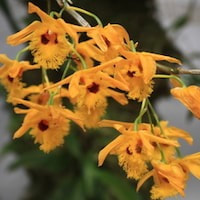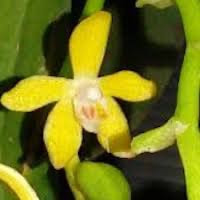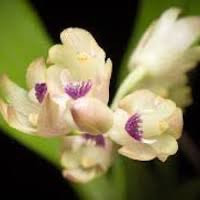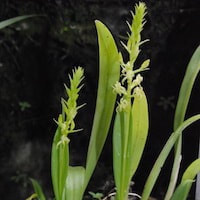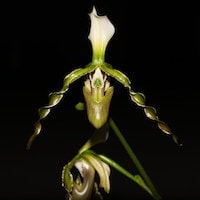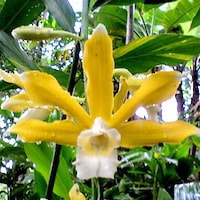WWD10- Women's Woody 10 - Herb it on the grapevine
|
Native Singaporean Orchid notes: Rhyncholaeliocattleya Ta-Shiang Yellow Dragon
Rhyncholaeliocattleya Ta-Shiang Yellow Dragon, valued for its delightful scent and visual appeal, plays a crucial role in the perfume "Woody 10 (Women)," crafted specifically for a Team Building Perfume Workshop. Known for its large, butter yellow to old gold flowers with a striking blue lip, this orchid adds aesthetic charm to the fragrance. Its enchanting scent, described as a blend of sweet florals with hints of freshness, enhances the perfume's femininity and elegance. Combining with woody and aromatic notes, it creates a harmonious and memorable olfactory experience, symbolizing unity and teamwork.
|
Therapeutic Orchid notes:
|
Dendrobium hookerianum Lindl.
Dendrobium hookerianum Lindl., known as "Gold Earring Dendrobium" or "Jiner Shihu" in Chinese, is renowned for its robust pseudobulbs and large, captivating flowers. This orchid's pseudobulbs are some of the largest in its genus, serving as reservoirs for water and nutrients that aid its survival in diverse environments. Its magnificent flowers, up to 10 cm across, feature striking combinations of white, yellow, and hues of purple or pink. Beyond its ornamental value, Dendrobium hookerianum is esteemed in traditional medicine, particularly in treating malaria and fever with decoctions from its pseudobulbs. Its broad distribution across Nepal, India, Bangladesh, Myanmar, and China underscores its cultural and ecological significance, attracting admiration from orchid enthusiasts and researchers alike. |
|
Diploprora championii (Lindl) Hook. f.
Diploprora championii, also known as "Yellow Hanging Orchid" or "Huangdiao Lan" in Chinese, is a fascinating vandaceous epiphytic orchid noted for its pendulous growth and flat leaves. Its Chinese names like "Daodiao Lan" and "Daochui Lan" highlight its graceful appearance as it hangs from trees. This orchid blooms across Asia from February to September in China, summer in Taiwan, and various times in other regions, ensuring its year-round presence. Known for its delicate and sweet fragrance, Diploprora championii is valued in traditional medicine for treating injuries and fractures in Taiwan and mainland China, underscoring its cultural significance and potential healing properties. |
|
Eria scabrilinguis Lindl. syn. Eria corneri Rchb. f.
Eria scabrilinguis, also known as "Banzhumao Lan" and other names in Chinese, is a captivating orchid celebrated for its fragrant yellow star-shaped flowers. Native to southern China and regions like Taiwan and Vietnam, it thrives in warm climates. Its sweet aroma makes it popular among orchid enthusiasts. In traditional Chinese medicine, it's called "Mengbi Lan" and used for its antipyretic properties to reduce fever and treat various ailments like lack of saliva and night sweats. Research is ongoing to understand its medicinal compounds and maximize its therapeutic potential. |
|
Liparis cespitosa (Lam.) Lindl.
Liparis cespitosa, known as "Xiaohuayanger Suan" and other names in Chinese, is a notable orchid prized for its unique fragrance and extensive geographic range across East Africa, the Himalayan foothills, southern China, Southeast Asia, and Pacific Islands. Flowering at different times like September, January, and March in Sri Lanka, its scent varies slightly by region but generally offers a pleasant floral and earthy aroma. In Taiwanese herbal medicine, the whole plant is used to treat fever and detoxify the body, while in Traditional Chinese Medicine (TCM), it's valued for its cooling properties to stop bleeding and balance bodily heat. Further scientific research is needed to fully uncover its medicinal compounds and therapeutic potential. |
|
Paphipedilum dianthum Tang et Wang syn. Paphiopedilum parishii (Rchb. f.) var. dianthum (Tang et Wang) Karasawa & Saito
Paphiopedilum dianthum, also known as "Changbanduo Lan" and "Shuanghuadou Lan" in Chinese, is a notable orchid celebrated for its enchanting scent and medicinal uses in traditional Chinese herbal medicine. This green-leaved epiphytic-lithophytic species thrives in southwest Guangxi, Guizhou, and southern Yunnan, typically found at altitudes between 1000 to 2300 meters in open forests on trees and rocks. Its fragrance is described as delightful, featuring floral notes with subtle sweetness and freshness, making it highly prized among orchid enthusiasts. In Chinese medicine, it is traditionally used for conditions related to swollen liver and spleen, reflecting its historical role in supporting detoxification and immune functions. While traditional uses provide insights, further scientific research is necessary to uncover its active compounds and therapeutic mechanisms fully, offering potential for future applications in medicine and perfumery. |
|
Phaius callosus Lindl.
Phaius callosus Lindl., known as Angkrek lemah in Sundanese, is an orchid species prized for its unique fragrance and traditional uses. Native to various Indonesian regions like Sumatra, Java, and Kalimantan, its floral scent features subtle sweet and earthy tones, appealing to orchid enthusiasts. In traditional Indonesian medicine, its roots are noted as "tart and sternutatory," capable of inducing sneezing and reviving the unconscious. These uses highlight the diverse roles plants play in cultural healing practices, though rigorous scientific study is needed to validate its medicinal benefits and chemical composition fully. |
Other scent note
Scentopia Library Reference ingredient
Tea Tree oil - Check details at Scentopia's scent library
Download the guided mediation that works best with this Orchid fragrance oil
| women_woody_essential_oil_orchi_00010.mp3 | |
| File Size: | 183442 kb |
| File Type: | mp3 |

